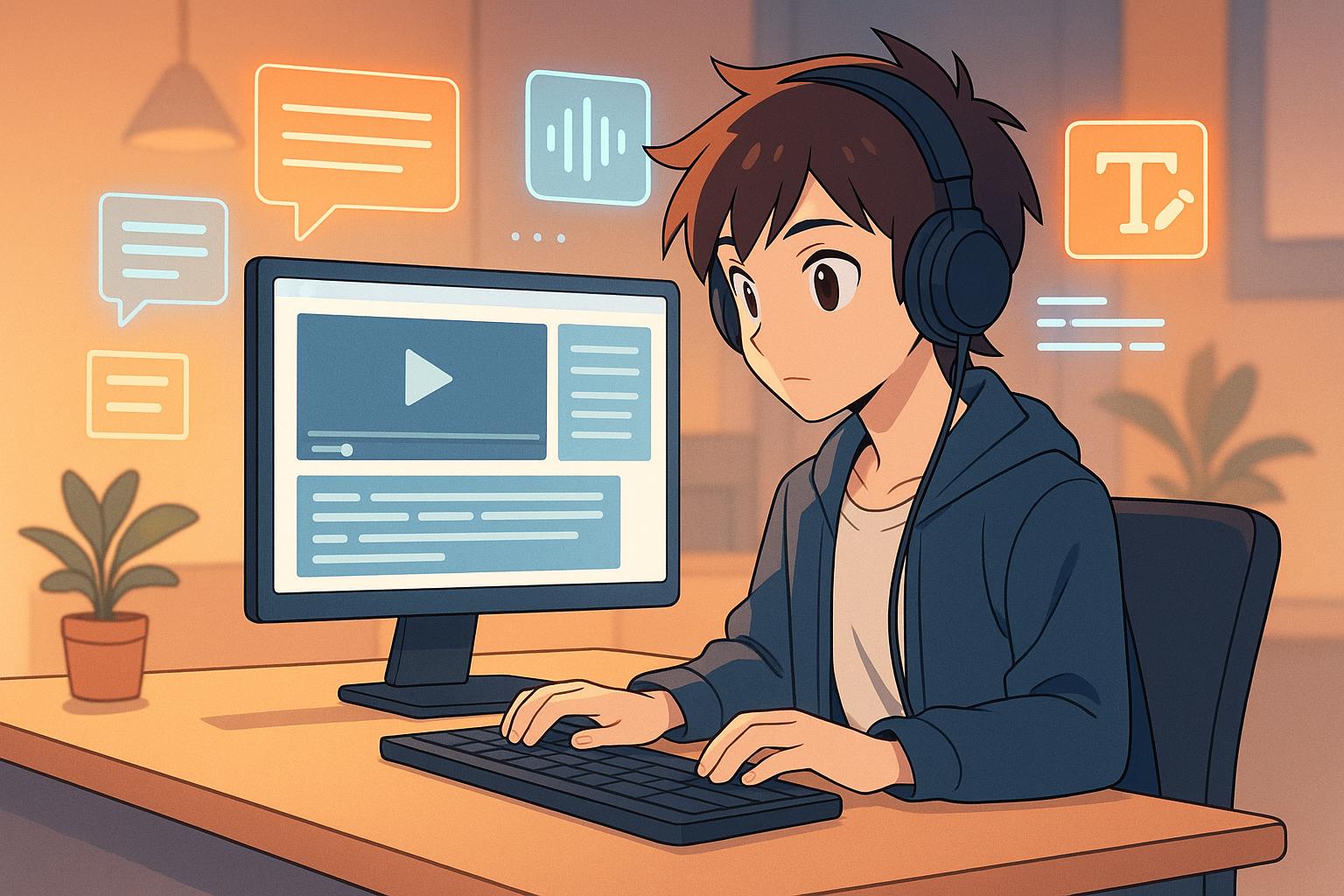AI is changing how videos are made, making them faster and more personal. Here’s what AI can do for video content:
- Edit Scenes Automatically: AI finds scene breaks, adjusts framing, and smooths transitions, cutting editing time by up to 90%.
- Personalize Content: Add names, dates, or locations dynamically without re-editing entire videos.
- Customize Voices: Adjust accents, tones, or speech styles to match audience preferences.
- Analyze Viewer Behavior: Track engagement to improve future videos and boost conversions.
- Localize for the U.S.: Convert measurements, adapt cultural references, and make content relatable for American audiences.
For example, businesses have seen up to a 16x increase in click-through rates and 40% more revenue by using AI-powered personalization. Whether you’re a video creator or a marketer, AI tools can save time and help connect with your audience better.
[Tutorial] Generate Personalized Event Videos with AI: End-to-End Make Scenario
1. AI Scene Editing Tools
AI-powered scene editing has completely transformed how videos are customized, making the process faster and more efficient without sacrificing quality. By using advanced pattern recognition, AI pinpoints natural scene breaks, significantly cutting down editing time. A great example? AfroLand TV managed to trim the editing time for a 30-second video from two hours to just 15 minutes. That’s a game-changer for creators pressed for time.
The technology doesn’t stop at identifying scene breaks. It also ensures that essential elements - like subjects and objects - stay properly framed within each scene. On top of that, AI fine-tunes technical details to create smooth, professional transitions. Some of the standout features include:
- Crossfade optimization for seamless transitions between scenes
- Aspect ratio adjustments, removing black bars for a polished look
- Dynamic object tracking, especially useful for converting videos to vertical formats
These tools take care of the nitty-gritty technical work, freeing up content creators to focus on the bigger picture and creative decision-making. It’s like having a virtual assistant for all the behind-the-scenes complexities of video editing.
2. Video Placeholder System
AI-powered video placeholders are transforming how we approach content customization. They allow for dynamic updates to names, dates, and locations without the need to recreate entire videos. Similar to AI-driven scene editing, this approach brings a new level of personalization without adding extra production effort.
Setting Up Video Placeholders
The process begins with AI transcribing your video. During transcription, it identifies and marks specific elements - like names, dates, and locations - as dynamic fields. These fields can then be updated automatically, ensuring your content stays relevant and fresh.
Automatic Content Updates
Once set up, the system can instantly adjust text, voice-overs, and visuals based on viewer data. And the results are nothing short of impressive. Businesses leveraging personalized video content have reported significant improvements across key metrics:
| Metric | Impact |
|---|---|
| Click-through rates | 16x increase |
| Unique click rates | 4.5x increase |
| Customer retention | Up to 35% improvement |
| Marketing effectiveness | 30% increase |
Beyond basic updates, the system allows for deeper and more context-specific customizations. This means your videos can adapt dynamically while catering to a variety of personalization needs.
Types of Video Personalization
Personalization isn’t just about swapping out text. The system supports a range of advanced customization options:
Geographic Personalization
PortoBay Hotels and Resorts showcased the potential of location-based personalization by delivering tailored privacy policy updates. This strategy led to a 70% increase in viewer attention rates.
Customer-Specific Content
Domino’s Pizza saw their conversion rates skyrocket from 22.19% to 47.73% by using personalized videos that catered directly to their customers’ preferences.
Dynamic Data Integration
The system can seamlessly integrate customer-specific details into videos, such as forms, invoices, or other personalized data. Long Tail Pro used this feature in an opt-in campaign, achieving a remarkable 46.95% conversion rate.
"SmartVideo technology is revolutionary. Compared to ebooks and PDFs, if you can integrate a personalized SmartVideo into your funnel, your conversions will surge." - Heather, Long Tail Pro CEO
For the best results, it’s important to create content that genuinely addresses your audience’s needs while staying authentic. Striking the right balance between personalization and practical value is crucial. For instance, retailers have reported up to 40% fewer returns by using personalized videos to provide accurate size visualizations and product demonstrations.
3. Voice Customization Features
AI-powered voice customization is transforming the way video content connects with audiences. Miscommunication in voice interactions can be costly - one study found that a 250-seat contact center in the US loses over $155,000 annually due to such issues. Modern AI tackles these problems head-on, offering advanced voice adaptation tools that enhance both clarity and personalization. Just as dynamic visuals have reshaped the viewer experience, precise audio customization ensures content feels tailored to individual preferences.
Regional Voice Settings
One standout feature of AI voice technology is its ability to adjust for regional accents and dialects. This is especially relevant in the US, where preferences can vary widely depending on geographic location. The system can fine-tune several elements of speech to reflect regional nuances:
| Voice Element | Customization Capability |
|---|---|
| Pronunciation | Adjusts to region-specific sounds |
| Intonation | Matches local speaking rhythms |
| Stress patterns | Reflects regional emphasis |
| Dialect | Adapts to geographic variations |
Why does this matter? Over one-third of US consumers prefer interacting with voices that feel locally familiar. This level of customization helps create a stronger connection with the audience.
Age-Based Voice Adjustments
AI doesn’t stop at regional customization - it also adapts voices to suit different age groups. With tools like Hume AI's EVI 2 model, creators can easily tweak vocal characteristics such as register, pace, emotional tone, and even vocabulary using an intuitive slider. A great example of this is Bearwith, an AI-powered social anxiety coach. In May 2025, it adopted Hume's Empathic AI technology to deliver voice interactions that felt more supportive and personalized, helping users feel understood during coaching sessions.
Business vs. Casual Voice Styles
AI also allows for seamless shifts between professional and casual speaking styles, making it easier to adapt to different communication contexts. For instance, in May 2025, Interview Optimiser integrated Hume's Empathic Voice Interface (EVI) to dynamically adjust voice tones based on whether the setting was formal or informal. Here’s how the system tailors voice styles:
| Style Element | Business Setting | Casual Setting |
|---|---|---|
| Tone formality | Polished and structured | Relaxed and conversational |
| Vocabulary | Uses industry-specific language | Everyday, approachable terms |
| Pace | Steady and deliberate | Natural and fluid |
| Emotional range | Restrained and professional | More expressive and engaging |
When combined with visual and text-based personalization, these voice adjustments create a deeply immersive and customized viewer experience. AI voice technology is not just about making content sound better - it’s about making it resonate on a personal level.
sbb-itb-1b61896
4. Audience Data Analysis
AI does more than just edit and personalize video content - it dives deep into audience data to refine and improve performance. According to recent studies, marketers using AI-powered analytics have seen engagement metrics climb by 20–50%.
Viewer Behavior Tracking
AI meticulously tracks viewer behavior, analyzing watch time, interactions, and drop-off points. This data provides actionable insights into how audiences engage with content. Here's a closer look at some key tracking elements:
| Tracking Element | What AI Analyzes | Impact on Customization |
|---|---|---|
| Temporal Patterns | Weekday vs. weekend viewing habits | Helps determine optimal posting times |
| Content Flow | Performance of individual scenes | Guides strategic placement of content |
| User Response | Drop-off points and rewatches | Refines content structure for better retention |
| Interaction Data | Click-through rates (CTRs) | Improves calls-to-action (CTAs) effectiveness |
By leveraging these insights, creators can craft personalized videos that significantly boost conversion rates - sometimes as much as threefold.
Content Testing Tools
AI also plays a critical role in testing video segments to enhance engagement. For example, an HR team used AI analytics to evaluate their compliance training videos. After identifying modules with high drop-off rates, they restructured the videos into shorter, more interactive segments. This change led to better comprehension and increased completion rates. These testing tools are invaluable for fine-tuning content and maximizing its impact.
Content Performance Data
AI’s ability to process large volumes of performance data is transformative. It focuses on three main indicators:
-
Engagement Metrics
AI identifies when engagement peaks, providing insights into audience preferences. The video analytics market reflects this growing reliance on data, with projections to expand from $8.3 billion in 2023 to $22.6 billion by 2028. -
Demographic Insights
By analyzing demographics, regional trends, and engagement behaviors, AI helps tailor content to specific audience segments. -
Content Optimization
AI pinpoints where viewers lose interest. For instance, one analysis of a product explainer video revealed a significant drop-off at the 45-second mark. After restructuring the content based on this insight, the video achieved higher completion rates and better product adoption.
These insights empower content creators to fine-tune video length, format, and structure, ensuring maximum engagement and effectiveness. AI-driven analytics transform raw data into actionable strategies that elevate audience connection.
5. US Market Content Adjustment
AI plays a key role in tailoring video content specifically for American audiences, slashing project timelines by up to 50% while enhancing viewer retention. This process involves more than just translation - it includes precise unit conversions and culturally relevant adjustments to make the content resonate.
Measurement Unit Conversion
One of the standout features is the automatic conversion of measurements into US standards in real time. Here's how it works:
| Original Format | US Market Conversion | AI Application |
|---|---|---|
| Celsius | Fahrenheit | Converts temperatures in cooking videos |
| Metric distances | Miles/feet/inches | Adjusts for fitness and DIY content |
| Kilograms/grams | Pounds/ounces | Updates weight measurements dynamically |
| Metric volumes | Cups/fluid ounces | Adapts recipe measurements for US kitchens |
These conversions are seamlessly integrated into dialogues, captions, and on-screen overlays, ensuring accuracy without disrupting the flow of the content.
US Reference Library
Beyond technical conversions, AI refines content by incorporating regional and cultural nuances that feel natural to US audiences. This includes:
- Adjusting regional terminology and idioms
- Incorporating references to US holidays and traditions
- Using sports analogies and entertainment themes popular in the US
- Replacing global brand mentions with US-specific equivalents
Recipe Video Localization
For recipe videos, AI goes a step further by tailoring every detail to align with American cooking habits and expectations. Key adjustments include:
-
Ingredient Measurements and Temperature Settings
AI converts ingredient quantities, adjusts oven temperatures, modifies oil heating instructions, updates refrigeration requirements, and ensures compliance with US food safety standards. -
Portion Sizes
Portions are analyzed and resized to align with typical US serving sizes, making recipes more relatable and practical for American viewers.
"Leveraging AI can lead to deeper connections with customers and improved brand loyalty."
The benefits are clear: AI-driven localization tools not only maintain high-quality standards but also cut production timelines in half. This allows creators to focus on their craft while AI handles the complex task of market-specific customization.
Conclusion: AI Video Personalization Benefits
AI-driven video personalization is reshaping how content is created and consumed. It delivers 3-4 times higher engagement compared to generic content and helps businesses outperform their competitors by around 30%. By integrating the advanced features discussed earlier, these tools simplify workflows while significantly boosting key performance metrics.
Here’s how AI personalization makes a measurable difference:
| Benefit Category | Performance Improvement |
|---|---|
| Conversion Rate | Increased from 22% to 47% |
| Viewer Attention | Improved by up to 70% |
| Purchase Likelihood | 80% higher with personalization |
These improvements are directly tied to AI's ability to deliver content tailored to individual preferences, creating a more meaningful connection with the audience.
"The personalization that you can leverage with AI allows the consumer or the subscriber to feel like you're talking to them one-on-one versus one-to-many"
This approach not only enhances engagement but also optimizes production processes, proving that AI personalization is a game-changer for video creators.
"AI gives us the opportunity to scale the unscalable. The key is using this creatively, thoughtfully, and putting the effort in upfront. If you put the effort in on the front end and create a great, thorough prompt, it will serve you for months or years to come, every day, on autopilot." - James Brooks, Marketer and Founder, Journorobo
With 91% of consumers stating that video quality influences their trust in a brand, AI-powered personalization has become an essential tool for today’s content creators, enabling them to connect with their audience on a deeper and more impactful level.
FAQs
How does AI simplify scene editing for video creators, and what are the benefits?
AI takes the hassle out of scene editing by spotting key moments in your footage, adding seamless transitions, and polishing visuals with effects. It can even create precise captions, making videos more inclusive and easier to understand. These features cut down on the time and effort creators spend on technical tasks, giving them more freedom to focus on storytelling and creativity.
By simplifying the editing process, AI enables creators to produce polished, tailored videos more quickly. This not only boosts engagement but also ensures the content connects with a wide range of viewers.
How does AI help customize video content to boost viewer engagement and retention?
AI brings video customization to a whole new level by aligning content with individual viewer preferences. It can adjust videos in real-time, responding to user behaviors like skipping or replaying certain parts, to create a viewing experience that feels more personal and relevant.
On top of that, AI-powered tools allow creators to produce tailored videos on a large scale without sacrificing quality. This approach not only boosts viewer satisfaction but also helps build deeper connections with the audience, leading to higher engagement and better retention rates.
How does AI make video content more relevant for U.S. audiences?
AI makes it easier to customize video content for U.S. audiences by automating tasks like translating text into American English, aligning cultural references with local sensibilities, and tweaking visuals or messaging to match regional tastes. It also fine-tunes content for local SEO, ensuring creators can connect with their intended audience more effectively.
For instance, AI can convert measurements to the imperial system, format dates in the U.S. style (MM/DD/YYYY), and weave in culturally familiar touches like holidays or commonly used slang. These tweaks help the content feel more natural and relatable to U.S. viewers, strengthening its appeal and fostering a stronger connection with the audience.


